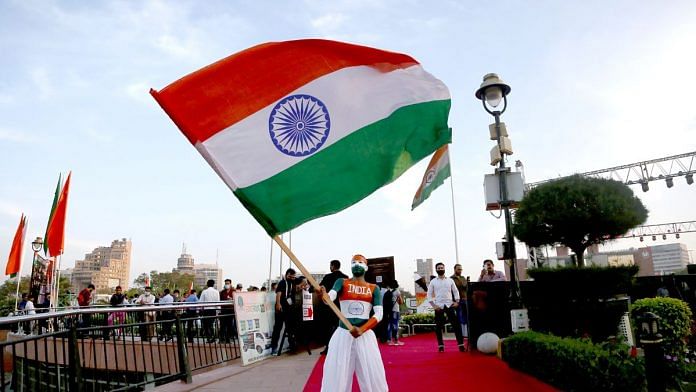
Thank you dear subscribers, we are overwhelmed with your response.
Your Turn is a unique section from ThePrint featuring points of view from its subscribers. If you are a subscriber, have a point of view, please send it to us. If not, do subscribe here: https://theprint.in/subscribe/
“At the stroke of the midnight hour, when the world sleeps, India will awake to life and freedom,” said India’s first Prime Minister Jawaharlal Nehru on 15 August 1947, while declaring the end of the British Empire in India. The predominant question remained: what would citizens do with the freedom attained? The lack of lucidity in narrative and opportunities was stumbling the grandness of the much awaited event in Indian history, alongside the communal tensions in Punjab and Bengal. The issue of various princely states and their dependence and demands of being independent was in itself exasperating for the then Home Minister Vallabhbhai Patel.
Enveloped with multiple concerns, India took a step forward in drafting and adopting its Constitution and became a Republic in 1950, while at the border front, India ensured that Jammu & Kashmir is united with India and Pakistani militants were defeated which came to be known as the first war between India and Pakistan.
Cut to 2022, India has already fought three wars with Pakistan and is constantly being nudged to go for the fourth due to Islamabad’s unending camaraderie with terrorist organisations. Then PM Jawaharlal Nehru signed the Panchsheel Agreement with China in the 1950s in order to “co-exist peacefully”. Although, till the time Vallabhbhai Patel was alive, he kept nudging Nehru to hold talks with China over the border line but latter was relaxed and complacent over his stance and relations with China. In 1962, China attacked India and in a full-scale war, the dragon also acquired around 40,000 square miles of land which is now known as ‘Aksai-Chin’.
Cut to 2020, India-China went into conflict over border dispute wherein 20 Indian soldiers were martyred but saved the Line of Actual Control (LAC) point which the Chinese were trying to overtake from India. China officially admitted that it lost four soldiers in the skirmish but unofficially, it was confirmed that the Liberation Army of China lost at least 42 personnel.
Although China was testing the waters in Ladakh, they weren’t contemplating such conjecture by the Indian forces who are always war ready. The border dispute remains active but politics and diplomacy are taking care of each other for now while the Chinese dispensation must have realised that unlike the 20th Century, India might not lose an inch of land as protecting the sovereignty of the country holds apex significance in the dynamic global world order.
At the space frontier, when the world was witnessing a space marathon between the US and then USSR in 1960’s and 1970’s, India was busy launching its first satellite (Aryabhata) in space. While the USSR sent Soviet pilot and cosmonaut Yuri Gagarin as the first human in space, it was the US which launched the Apollo 11 mission and ensured Neil Armstrong and Buzz Aldrin touched down on the Moon.
India was far behind in this space race, and was moving at a snail speed when the turning point came in the name of an aerospace engineer Nambi Narayanan. He was working for the Indian Space Research Organisation (ISRO) under the then chief Vikram Sarabhai. In 1969, Narayanan won a prestigious NASA fellowship that helped him find his way into Princeton University, where he gained expertise in chemical rocket propulsion. He was probably the first Indian scientist to have completed his Masters degree from an Ivy League college and that too in a record time of only 10 months and that too under the guidance of Professor Luigi Crocco, who is considered to be one of the pioneers and leading forces in the fields of theoretical aerodynamics and rocketry and jet propulsion.
Upon returning to India, where solid motors were common, to everyone’s astonishment, including Dr APJ Abdul Kalam, Nambi introduced liquid propellant motors. It was Narayanan and his team that developed the Vikas engine, used by ISRO for many of its rockets, including the Polar Satellite Launch Vehicle (PSLV) and Geosynchronous Satellite Launch Vehicle (GSLV). Although India lost the space race in 1994 when Nambi and his team, who were working on the cryogenic engine fuelled by liquid propellant which could have been a game changer for India, were charged with false cases of espionage. The Supreme Court vindicated Nambi in 2018 but India was pushed around two decades back in the space race, which is currently dominated by the US, France, Russia etc.
India’s grit in sporting events has even got the West and South Asia crumbling whether it is Badminton, Hockey, Wrestling, Cricket, Table Tennis etc. India’s story surely had roadblocks and shortcomings but in the last 75 years, India has not only achieved milestones but it has changed the perspective and discourse of the world arena towards it.
These pieces are being published as they have been received – they have not been edited/fact-checked by ThePrint.

COMMENTS